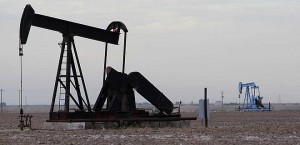 West Texas Intermediate crude hovered near the lowest level since the beginning of February after weaker-than-expected data from China added to recently built up concerns over an economic slowdown in the worlds second-biggest oil consumer. The oil market remained under pressure after government data showed US crude supplies rose three times more than expected, while the US also announced a test sale of oil from its emergency oil stockpiles. An upward revised global demand growth forecast by OPEC put a floor under prices.
West Texas Intermediate crude hovered near the lowest level since the beginning of February after weaker-than-expected data from China added to recently built up concerns over an economic slowdown in the worlds second-biggest oil consumer. The oil market remained under pressure after government data showed US crude supplies rose three times more than expected, while the US also announced a test sale of oil from its emergency oil stockpiles. An upward revised global demand growth forecast by OPEC put a floor under prices.
On the New York Mercantile Exchange, WTI crude for delivery in April traded at $98.13 per barrel at 7:54 GMT, up 0.14% on the day. Prices plummeted little over 2% on Wednesday to settle at $97.99, the lowest close since February 6th and the steepest daily decline since June 2. This marked a third straight day of losses, the longest losing streak in two months.
Meanwhile on the ICE, Brent futures for settlement in the same month were up by 0.27% at $108.31 per barrel, having shifted in a daily range between $108.11 and $108.51 a barrel. The European benchmark lost 0.5% on Wednesday and settled at $108.02 a barrel, the lowest this week. Brent traded at a premium of $10.18 a barrel after it widened to $10.03 on Wednesday from $8.52 on Tuesday, based on closing prices.
Oil prices were pinned down near multi-week lows on Thursday after another series of downbeat data points from China spurred demand fears. The National Bureau of Statistics reported that the Asian nations industrial production expanded by 8.6% in the January-February period, compared to a 9.7% growth during the same months a year earlier. Analysts had expected a minor slowdown to a 9.5%-expansion.
Michael McCarthy, a chief market strategist at CMC Markets in Sydney, said for Bloomberg: “It’s not an improving picture with a very weak rating on industrial production. We could see oil under pressure over the remainder of this session.”
At the same time, retail sales rose by 11.8% year-on-year, also trailing expectations for a minor retreat to an expansion of 13.5%, compared to last years 13.6% growth.
This comes after Chinas statistics agency reported on Saturday that the Asian nation’s exports surprisingly contracted by 18.1% in February on an annual basis, confounding analysts’ expectations for a 6.8% expansion following January’s 10.6% growth.
US inventories
Prices were further pressured after the Energy Information Administration reported on Wednesday an eight consecutive weekly build in US crude oil inventories. Supplies rose by 6.18 million barrels in the seven days through March 7th, sharply exceeding a projected 2-million increase, according to a weekly Bloomberg survey of 10 analysts. At 370.0 million barrels, the highest since December 13th, U.S. crude oil inventories are in the upper half of the average range for this time of year.
Prices drew some support as inventories at Cushing, Oklahoma, the biggest US storage hub and delivery point for NYMEX-traded contracts, fell by 1.3 million barrels to a two-year low of 30.8 million, marking a sixth straight weekly drop. Analysts however feared that the southern leg of TransCanada’s KeystoneXL pipeline, which began delivering crude from Cushing to the Gulf Coast in January, merely carried the bottleneck to Texas, having shown no effect on nationwide stockpiles levels so far.
The build was partially attributed to a drop in refinery utilization rate as units were shut for spring maintenance. Refineries operated at a four-month low of 86.0% of their operable capacity last week, down 1.4% from a week earlier. Gasoline and distillate fuel production both increased last week, averaging 9.4 and 4.6 million barrels per day, respectively.
Total motor gasoline supplies fell by 5.2 million barrels last week to 223.8 million, outperforming expectations for a drop of 2 million barrels, while distillate fuel inventories declined by 0.5 million barrels to 113.9 million, in line with forecasts for a 450 000-barrel drop.
Strategic Petroleum Reserve
Also weighing on the market, the US Energy Department announced a surprise plan to sell 5 million barrels of oil from its emergency stockpiles in order to test the nations distribution system. This would amount to less than 1% of the countrys reserves, the first release since August 1990, and was seen as a message toward Russia and its intentions of annexing Crimea.
Support
Oil however drew support by the unfolding crisis in Ukraine after the European Union agreed on a framework yesterday for its first sanctions against Russia since the Cold War.
Also underpinning the market, the Organization of the Petroleum Exporting Countries raised its forecast for global demand growth in 2014 for a second consecutive month, contrasting with the Energy Information Administration’s forecast reduction on Tuesday.
The 12-member group said in its monthly report that global demand will jump by 1.14 million barrels per day this year, up 50 000 from its previous estimate, while also raising the forecast for global demand of crude pumped by it. The upward revision was based on projections for accelerating economic growth in the US and Europe, while a slowdown in emerging economies, especially China, was raising concerns and capping gains. Economists expect an upward revision to the US fourth-quarter GDP growth after services industry data suggested a stronger pace of consumer spending than previously expected.
The group also reported that its total crude output rose by 258 600 barrels per day last month to an average of 30.1 million bpd, the strongest level since August, as Iraq offset supply shortages in Libya and Saudi Arabia.
In the latest series of chaos in the African producer, the Libyan parliament deposed Prime Minister Ali Zeidan due to his inability to regain control of the country’s oil production, its main source of revenue. The vote came after rebels humiliated the government as a tanker loaded crude oil at a rebel-held export terminal and fled from Libya’s navy.
According to the state-run National Oil Corporation, the African country’s output stood at 441 000 bpd on Wednesday, up from 392 000 bpd a day earlier. Libya, the holder of Africa’s biggest crude reserves, pumped an average of 350 000 bpd last month, down from 1.4 million bpd in March 2013 as eastern ports remained under the control of rebel groups, while the El Sharara oilfield was blocked by protesters.





